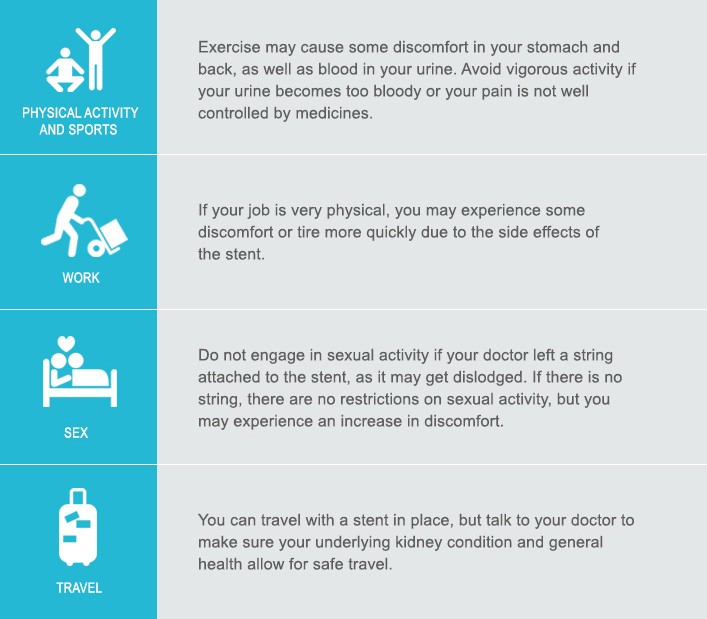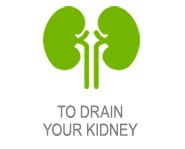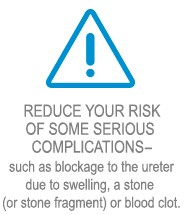Treatment During COVID-19
Ureteral Stent Placement
You may have been recently diagnosed with a kidney stone, and as part of your treatment, you may have received a ureteral stent to help pass urine from your kidney to your bladder.
To help answer questions you may have, this page provides information about: the benefits associated with a ureteral stent, common side effects and day-to-day life with a ureteral stent.
Be aware of these common side effects from a ureteral stent:
- Discomfort and pain, usually experienced as a dull feeling in your sides and groin, and can get worse while you are urinating.
- Blood in your urine. The color can range from light pink to reddish and sometimes can even have a brownish hue – but you should be able to see through it. (Medications to help with burning sensation during urination can sometimes turn urine orange or blue.) If bleeding increases significantly, call your doctor immediately or go to an emergency room for evaluation.
- A feeling of fullness and a constant need to urinate (urgency and frequency).
- Pain, pressure or a burning sensation during urination or when you move.
- Bladder muscle spasms.
- Leakage of urine due to the inability to make it to a toilet in time.
- Feeling of not completely emptying your bladder.
- Nausea and occasional vomiting.
Follow your doctor’s instructions and remember to:
- Drink plenty of fluids.
- Take pain medicines as prescribed to relieve any discomfort from surgery or your stent.


Stent Displacement
A stent does not typically fall out. However, if your stent gets dislodged, you may experience constant urinary incontinence that requires a protective pad. This is not a life-threatening situation, but you should contact your doctor or go to an emergency room for evaluation. Very rarely, a stent can migrate and require removal or re-positioning.
If you have a string attached to your stent, make sure to not pull on or snag the string since this can lead to stent dislodgement or movement.
Stent Removal
A ureteral stent is typically removed four to seven days after surgery during a short office procedure, although sometimes the stent must stay in longer.
Most patients stay awake when a stent is removed, but you may have a numbing gel applied to your urethra (your urinary tract opening) before the procedure. If your stent has a string attached, your doctor gently pulls on it to remove the stent. If there is no string, your doctor uses a scope to grasp the stent coil in the bladder and gently pull it out through the urethra.
Download the Patient Brochure
A Patient Guide to Having a Ureteral Stent
Your Questions Answered
File type: PDF




